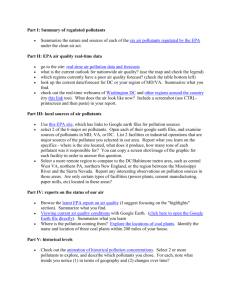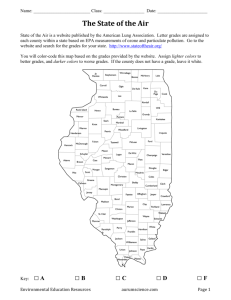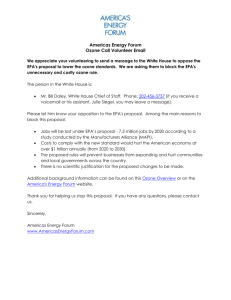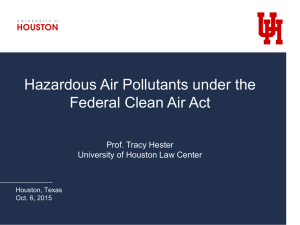Matters
advertisement
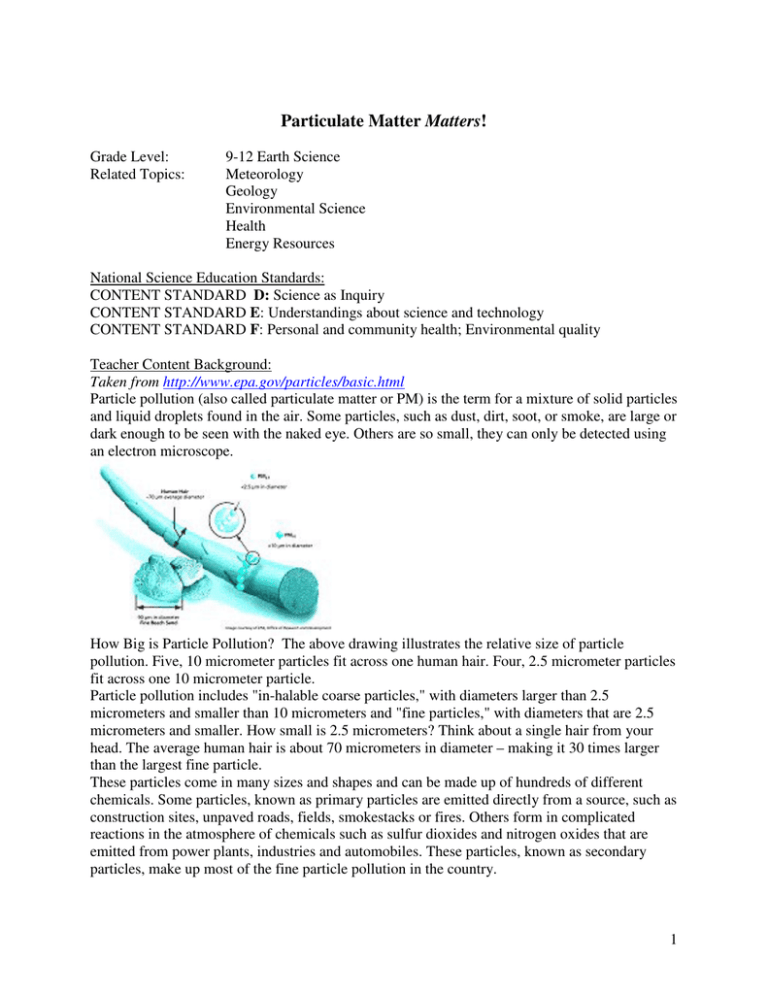
Particulate Matter Matters! Grade Level: Related Topics: 9-12 Earth Science Meteorology Geology Environmental Science Health Energy Resources National Science Education Standards: CONTENT STANDARD D: Science as Inquiry CONTENT STANDARD E: Understandings about science and technology CONTENT STANDARD F: Personal and community health; Environmental quality Teacher Content Background: Taken from http://www.epa.gov/particles/basic.html Particle pollution (also called particulate matter or PM) is the term for a mixture of solid particles and liquid droplets found in the air. Some particles, such as dust, dirt, soot, or smoke, are large or dark enough to be seen with the naked eye. Others are so small, they can only be detected using an electron microscope. How Big is Particle Pollution? The above drawing illustrates the relative size of particle pollution. Five, 10 micrometer particles fit across one human hair. Four, 2.5 micrometer particles fit across one 10 micrometer particle. Particle pollution includes "in-halable coarse particles," with diameters larger than 2.5 micrometers and smaller than 10 micrometers and "fine particles," with diameters that are 2.5 micrometers and smaller. How small is 2.5 micrometers? Think about a single hair from your head. The average human hair is about 70 micrometers in diameter – making it 30 times larger than the largest fine particle. These particles come in many sizes and shapes and can be made up of hundreds of different chemicals. Some particles, known as primary particles are emitted directly from a source, such as construction sites, unpaved roads, fields, smokestacks or fires. Others form in complicated reactions in the atmosphere of chemicals such as sulfur dioxides and nitrogen oxides that are emitted from power plants, industries and automobiles. These particles, known as secondary particles, make up most of the fine particle pollution in the country. 1 EPA regulates inhalable particles (fine and coarse). Particles larger than 10 micrometers (sand and large dust) are not regulated by EPA. * Health: Particle pollution contains microscopic solids or liquid droplets that are so small that they can get deep into the lungs and cause serious health problems. The size of particles is directly linked to their potential for causing health problems. Small particles less than 10 micrometers in diameter pose the greatest problems, because they can get deep into your lungs, and some may even get into your bloodstream. * Visibility: Fine particles (PM2.5) are the major cause of reduced visibility (haze) in parts of the United States, including many of our treasured national parks and wilderness areas. * Reducing particle pollution: EPA’s national and regional rules to reduce emissions of pollutants that form particle pollution will help state and local governments meet the Agency’s national air quality standards. Please also refer to… http://www.epa.gov/particles/ http://www.arl.noaa.gov/ready/ash.html Essential Learnings: Students will construct working definitions of criteria pollutants and of particulate matter. Students will analyze real-time air quality data. Students will correlate particulate matter levels with health concerns. The Lessons: The following lessons are designed to complement the middle level science activities “Be Particulate About Your Matter” in STORM project book. Please refer to mentioned lessons for details. Engage: Cloud in a Bottle Materials: clear two-liter bottles with lids 1 bottle per student or student pair Warm water 1/4 cup or less works well – you want about ½ inch or less in bottom of bottle. Don’t have too warm of water – you don’t want condensation occurring on the inside bottle surface. Matches Safety Alert! Students may need goggles and careful monitoring 1. Put a small amount of warm water in the bottle. Close the lid. 2. Squeeze the bottle as tight as you can. Now release the bottle. What happens? 3. Take off the lid. Light a match. Let it burn for just a bit. Now as quickly as possible, blow out the match, put it in the bottle and re-close the lid. (idea is to get as much smoke into bottle as possible) 4. Squeeze the bottle as tight as you can. Now release the bottle. What happens? 5. Was there a difference this time? Why or why not? Possible Teacher Discussion points: What happened when we put the match into the bottles? We added smoke to the system. By adding the smoke, we were able to make clouds. Besides smoke, what other materials do you think are in our atmosphere? move into next activity 2 Possible Extension: 6. What happens when we squeeze the bottle? (we increase pressure/temperature) 7. What are clouds? (water droplets) How do they form? (condensing onto particles in the air) What is needed? (condensation nuclei, temperatures, moisture content) Explore: What’s in Our Air? Materials: Petri dishes and/or microscope slides Petroleum jelly 2 sided sticky tape, packing tape and/or other tapes Open outdoor area for # hours x # days of activity Other materials as needed/requested by students Magnifying lenses Microscopes (dissecting or compound) Possible Teacher Discussion points: To answer our question of what may also be in our air, you are going to design an experiment. The goal of our activity is to understand what different materials are in our atmosphere. 1. Each group will devise a plan for collecting samples from the atmosphere. Instruct students to write out their plan and obtain a teacher check before proceeding. 2. Each student will make one slide (or other collection device) to put outdoors and one to put indoors. Be sure the area will be undisturbed (grass mowing, sprinkler systems, etc.. If winds or rain are in forecast, you may need to adjust.) 3. Place the collection devices outside and in the classroom for 24 hours. 4. The next day have students collect and count, draw and try to identify what they find on their slides. Have students develop their method of communication (data table, graph, etc.) and explain why they chose it (how it is more helpful/meaningful than other methods). 5. Share group data by posting around room with poster/chart paper, white boards, or other such means. (Note: students may start by using hand lenses and come to the conclusion that they must move to dissecting microscopes or lower power on their compound microscopes.) 6. What are the possible sources for the items we found? (Natural vs. human influence) Possible Data Table construction: Date # counted sizes drawing identification Possible Questions for Students: 1. What item was most common on our collection devices? …least common? 2. Are all pollutants visible? Explain. 3 Explain Background Information: taken from http://www.epa.gov/air/caa/peg/concern.html and http://www.epa.gov/air/caa/peg/cleanup.html Why Should You Be Concerned About Air Pollution? You could go days without food and hours without water, but you would last only a few minutes without air. On average, each of us breathes over 3,000 gallons of air each day. You must have air to live. However, did you know that breathing polluted air can make you sick? Air pollution can damage trees, crops, other plants, lakes, and animals. In addition to damaging the natural environment, air pollution also damages buildings, monuments, and statues. It not only reduces how far you can see in national parks and cities, it even interferes with aviation. In 1970, Congress created the Environmental Protection Agency (EPA) and passed the Clean Air Act, giving the federal government authority to clean up air pollution in this country. Since then, EPA and states, tribes, local governments, industry, and environmental groups have worked to establish a variety of programs to reduce air pollution levels across America. Six common air pollutants (also known as "criteria pollutants") are found all over the United States. They are particle pollution (often referred to as particulate matter), ground-level ozone, carbon monoxide, sulfur oxides, nitrogen oxides, and lead. These pollutants can harm your health and the environment, and cause property damage. For information about the criteria pollutants, visit EPA's website at www.epa.gov/air/urbanair. EPA Geographic Air Data Analysis Activity Materials: Student access to internet (best if students can work individually) In this exercise, you will collect data on NAAQS exceedances for 2007. You will be collecting data for your home state and 5 others for 6 of the 7 criteria air pollutants. The data is accessed from the EPA Web site noted on our course homepage as EPA AirData. To access data, follow this procedure: 1. Go to the website http://www.epa.gov/air/data/geosel.html 2. Click on the desired state 3. Click on the “Go!” icon (lower right-hand corner, next to map) 4. Using the “Monitoring” block of links (blue), select the “Monitor Values” link under the Reports header for the Criteria Air Pollutants 5. Select the desired pollutant from the drop down menu 6. Scroll farther down the page and set the “Lines per Page” option to 500 7. Select “Generate Report” 8. Complete the tables (see Appendix 1) and answer student questions. Student Questions: a. You analyzed data showing levels of six pollutants. Why do you think the EPA is interested in these six? Are there other pollutants? Why is there a focus on just six instead of all pollutants? b. Of the six pollutants investigated, which one or ones would you say are most “troublesome” for your state? Explain your answer. c. Is your answer for #1 the same for all states surveyed? Explain your answer. 9. Using student answers from c. create definition of criteria pollutant. 10. Relate EPA Geographic Air Data Analysis Activity knowledge to What’s in Our Air activity data. Create definitions of particulate matter. 4 Content Information: taken from http://www.epa.gov/air/caa/peg/cleanup.html Of the six pollutants, particle pollution and ground-level ozone are the most widespread health threats. Particle pollution, also known as particulate matter (PM), includes the very fine dust, soot, smoke, and droplets that are formed from chemical reactions, and produced when fuels such as coal, wood, or oil are burned. For example, sulfur dioxide and nitrogen oxide gases from motor vehicles, electric power generation, and industrial facilities react with sunlight and water vapor to form particles. Particles may also come from fireplaces, wood stoves, unpaved roads, crushing and grinding operations, and may be blown into the air by the wind. EPA scientists and other health experts are concerned about particle pollution because very small or "fine" particles can get deep into the lungs. These fine particles, by themselves, or in combination with other air pollutants, can cause increased emergency room visits and hospital admissions for respiratory illnesses, and tens of thousands of deaths each year. They can aggravate asthma, cause acute respiratory symptoms such as coughing, reduce lung function resulting in shortness of breath, and cause chronic bronchitis. The elderly, children, and asthmatics are particularly susceptible to health problems caused by breathing fine particles. Individuals with pre-existing heart or lung disease are also at an increased risk of health problems due to particle pollution. Particles also cause haze reducing visibility in places like national parks and wilderness areas that are known for their scenic vistas. These are places where we expect to see clearly for long distances. In many parts of the United States, pollution has reduced the distance and clarity of what we see by 70 percent. Fine particles can remain suspended in the air and travel long distances with the wind. For example, over 20 percent of the particles that form haze in the Rocky Mountains National Park have been estimated to come from hundreds of miles away. Particles also make buildings, statues and other outdoor structures dirty. Trinity Church in downtown New York City was black until a few years ago, when cleaning off almost 200 years worth of soot brought the church's stone walls back to their original light pink color. Before the 1990 Clean Air Act went into effect, EPA set limits on airborne particles smaller than 10 micrometers in diameter called PM10. These are tiny particles (seven of these particles lined up next to each other would cover a distance no wider than a human hair). Research has shown that even smaller particles (1/4 the size of a PM10 particle) are more likely to harm our health. So in 1997, EPA published limits for fine particles, called PM2.5. To reduce particle levels, additional controls are being required on a variety of sources including power plants and diesel trucks. *Teacher Note- possible activity if website access unavailable for students: DNR Most Wanted cards (See www.iowadnr.com/air/citizen/educate/info.html for examples of cards) Instruct students to answer the following questions with partners. 1. Black Lung Benny lists PM 2.5 pollutant. What is PM 2.5? 2. How does PM 2.5 become a pollutant? 3. Granny Olga Ozone lists Ozone as a pollutant. Isn’t ozone the stuff that everyone is concerned about that we are loosing from our atmosphere? Explain how Ozone can be a pollutant and how it is different from the Ozone in our upper atmosphere. 5 4. Sicko lists microbes and bacteria as the pollutant. How do microbes and bacteria become pollutants? Give specific examples. 5. Otto the Oxman lists Dioxin as the pollutant. Explain what Dioxin is. Give examples of this type of pollutant and how it becomes a pollutant. 6. Sediment Sally can be easily stopped. Give some specific examples of how we can stop Sediment Sally in our water supplies in your state. 7. Punky P’s pollutant is Phosphorus. This can act just like other fertilizers in our water. Explain what happens when this gets into our surface water. What is this process called? 8. Backyard Haze Harry can be stopped. What can you do to stop him? Give some specific examples. 9. There are other pollutants out there. Create a most wanted card of your own. You will need to create another pollutant (not use one already on a card). Unfortunately there are plenty of pollutants out there! The format should be the same as these cards (Description, Crime, Cause, and Arrest). “The Big 6” Criteria Flipbook Activity Students will create notes on each criteria pollutant regarding EPA air quality standards, Clean Air Act implementation, and preventative measures. By using the flipbooks, students are limited in space and gain skills in summarizing information. Materials: 2 pages printer paper per student scissors Color pencils/markers/other 1. Fold each sheet of printer paper in ½ long ways (hotdog style). Cut along fold. Align the four strips so that they are staggered in height. Fold bottoms up to make a total of 8 flips. Staple at bottom fold. 2. Label front flip with student name and other class information. 3. Label each flip with one criteria pollutant. (Within the flip, students will include “air quality standards” and “implementation.”) 4. Label last flip with “ways to prevent” 5. Go to http://www.epa.gov/ttn/naaqs/ National Ambient Air Quality Standards (NAAQS) The Clean Air Act, which was last amended in 1990, requires EPA to set National Ambient Air Quality Standards (40 CFR part 50) for pollutants considered harmful to public health and the environment. The Clean Air Act established two types of national air quality standards. Primary standards set limits to protect public health, including the health of "sensitive" populations such as asthmatics, children, and the elderly. Secondary standards set limits to protect public welfare, including protection against decreased visibility, damage to animals, crops, vegetation, and buildings. The EPA Office of Air Quality Planning and Standards (OAQPS) has set National Ambient Air Quality Standards for six principal pollutants, which are called "criteria" pollutants. They are 6 listed below. Units of measure for the standards are parts per million (ppm) by volume, milligrams per cubic meter of air (mg/m3), and micrograms per cubic meter of air (µg/m3). National Ambient Air Quality Standards Pollutant Carbon Monoxide Lead Nitrogen Dioxide Particulate Matter (PM10) Particulate Matter (PM2.5) Ozone Sulfur Dioxide Primary Standards Level Averaging Time 9 ppm (10 mg/m3) 35 ppm (40 mg/m3) 0.15 µg/m3 (2) 1.5 µg/m3 0.053 ppm (100 µg/m3) 150 µg/m3 15.0 µg/m3 35 µg/m3 0.075 ppm (2008 std) 0.08 ppm (1997 std) 0.12 ppm 0.03 ppm 0.14 ppm Secondary Standards Level Averaging Time 8-hour (1) None 1-hour (1) Rolling 3-Month Average Quarterly Average Annual (Arithmetic Mean) 24-hour (3) Same as Primary Same as Primary Same as Primary Annual (4) (Arithmetic Mean) 24-hour (5) 8-hour (6) Same as Primary 8-hour (7) Same as Primary 1-hour (8) (Applies only in limited areas) Annual (Arithmetic Mean) 24-hour (1) Same as Primary Same as Primary Same as Primary Same as Primary 0.5 ppm (1300 µg/m3) (1) Not to be exceeded more than once per year. (2) Final rule signed October 15, 2008. (3) Not to be exceeded more than once per year on average over 3 years. 3-hour (1) (4) To attain this standard, the 3-year average of the weighted annual mean PM2.5 concentrations from single or multiple community-oriented monitors must not exceed 15.0 µg/m3. 7 (5) To attain this standard, the 3-year average of the 98th percentile of 24-hour concentrations at each population-oriented monitor within an area must not exceed 35 µg/m3 (effective December 17, 2006). (6) To attain this standard, the 3-year average of the fourth-highest daily maximum 8-hour average ozone concentrations measured at each monitor within an area over each year must not exceed 0.075 ppm. (effective May 27, 2008) (7) (a) To attain this standard, the 3-year average of the fourth-highest daily maximum 8-hour average ozone concentrations measured at each monitor within an area over each year must not exceed 0.08 ppm. (b) The 1997 standard—and the implementation rules for that standard—will remain in place for implementation purposes as EPA undertakes rulemaking to address the transition from the 1997 ozone standard to the 2008 ozone standard. (8) (a) The standard is attained when the expected number of days per calendar year with maximum hourly average concentrations above 0.12 ppm is < 1. (b) As of June 15, 2005 EPA revoked the 1-hour ozone standard in all areas except the 8-hour ozone nonattainment Early Action Compact (EAC) Areas. 6. Summarize information regarding EPA air quality standards and implementation practices onto the flipbooks. 7. Go to http://www.epa.gov/airnow/airaware/day5.html 8. On last page of flipbook give examples of how YOU can improve air quality. (Students may also want to access http://www.epa.gov/highschool/air.htm or http://www.epa.gov/highschool/ ) Extend Background Information: taken from SpareTheAir.com Particulate Matter is a complex mixture that may contain soot, smoke, metals, nitrates, sulfates, dust, water and tire rubber. It can be directly emitted, as in smoke from a fire, or it can form in the atmosphere from reactions of gases such as nitrogen oxides. The size of particles is directly linked to their potential for causing health problems. Small particles (known as PM2.5 or fine particulate matter) pose the greatest problems because they can get deep into your lungs and some may even get into your bloodstream. Exposure to such particles can affect both your lungs and your heart. Scientific studies have linked long-term particle pollution, especially fine particles, with significant health problems including: * Increased respiratory symptoms, such as irritation of the airways, coughing or difficulty breathing * Decreased lung function * Aggravated asthma * Development of chronic respiratory disease in children * Development of chronic bronchitis or chronic obstructive lung disease * Irregular heartbeat * Nonfatal heart attacks 8 * Premature death in people with heart or lung disease, including death from lung cancer Short-term exposure to particles (hours or days) can: * Aggravate lung disease causing asthma attacks and acute bronchitis * Increase susceptibility to respiratory infections * Cause heart attacks and arrhythmias in people with heart disease Even if you are healthy, you may experience temporary symptoms, such as: * Irritation of the eyes, nose and throat * Coughing * Chest tightness * Shortness of breath Quality Air = Quality Life Materials: internet access for individual or student pairs Air Quality Index sheet (see Appendix 2) 1. go to http://airnow.gov/ 2. Look at the National Overview. Using the colored index, rate the quality of the air as a nation. Are there areas of better quality than others? Propose an explanation of how this could be. 3. Go to Local Air Quality Conditions and Forecasts and enter in your state. 4. How many monitoring stations are there in your state? Where are the monitoring stations located? Answer questions 5. & 6. for each monitoring station: 5. What is the primary pollutant listed? What are the current quality conditions? What are the forecasted conditions? 6. What secondary pollutants are listed? What are the current quality conditions for each? What are the forecasted conditions for each? 7. An extended family is planning a reunion for 30 or so family members. They are to meet in Davenpor, Iowa t tomorrow. (Teacher Note: use regional cities/communities for example) The family is planning on having a baseball game, game of horseshoes, and a bike ride in addition to a picnic. An uncle, two aunts, and four cousins have heart disease. Several cousins have asthma. There will be both sets of grandparents at the picnic as well as one great-grandparent. Based on what you know about weather patterns and your Air Quality data, is tomorrow the best day for the reunion activities. Why or why not? Evaluate The following questions could be posed on a formal assessment or as a project assessment. Answers will vary according to state. (Projects could include PowerPoint, report, poster, video, skit, or other.) 1. How would you rate the overall quality of our state’s air? 2. What advantages/disadvantage do we have in our state against pollutants? 3. What are some possible "warning signs" about pollution levels in our state? 4. How have your ideas about pollution and pollution prevention changed over this unit. Explain any changes or reasons for no changes. 9 Sample project assessment rubric: Name: ________________________ Teacher: _________________________ Date of Presentation: ____________ Title of Work: ___________________ Criteria 1 Organization Content Knowledge Visuals Mechanics Delivery 2 Points 3 Audience cannot Audience has Student presents understand presentation difficulty following information in because there is no presentation because logical sequence sequence of student jumps which audience can around. follow. information. Student is Student does not have uncomfortable with grasp of information; information and is student cannot answer able to answer only rudimentary questions about subject. questions. Student occasional used visuals that Student used no visuals. rarely support text and presentation. Student's presentation Presentation had had four or more three misspellings spelling errors and/or and/or grammatical grammatical errors. errors. Student mumbles, Student incorrectly incorrectly pronounces pronounces terms. terms, and speaks too Audience members quietly for students in have difficulty the back of class to hear. hearing presentation. Student is at ease with content, but fails to elaborate. Visuals related to text and presentation. 4 Student presents information in logical, interesting sequence which audience can follow. Student demonstrates full knowledge (more than required)with explanations and elaboration. Student used visuals to reinforce screen text and presentation. Presentation has no Presentation has no more than two misspellings or misspellings and/or grammatical errors. grammatical errors. Student used a Student's voice is clear voice and clear. Student correct, precise pronounces most pronunciation of words correctly. terms. Total----> ____ ____ ____ ____ ____ ____ Teacher Comments: 10 Appendix 1 Carbon Monoxide What is the NAAQS (same as “EPA Air Quality Standards”) for 1-hour average _______________ 8-hour average _______________ State # of monitoring sites number of 1-hr exceedances number of 8-hour exceedances Your home state California Colorado District of Columbia Georgia Texas Nitrogen Dioxide What is the NAAQS (same as “EPA Air Quality Standards”) for annual average _______________ State # of monitoring sites number of annual exceedances Your home state California Colorado District of Columbia Georgia Texas Ozone What’s the difference between “# Exceed - Actual” and “# Exceed - Estimated”? What is the NAAQS (same as “EPA Air Quality Standards”) for 1-hour average _______________ 8-hour average _______________ State # of mon. sites estimated number of 1hr exceedances number of days when 8hour values > standard Your home state California Colorado District of Columbia Georgia Texas 11 PM 10 What is the NAAQS (same as “EPA Air Quality Standards”) for 24-hour average _______________ annual average _______________ State # of mon. sites number of 24-hr exceedances-estimated number of annual exceedances Your home state California Colorado District of Columbia Georgia Texas PM 2.5 What is the NAAQS (same as “EPA Air Quality Standards”) for 24-hour average _______________ annual average _______________ State # of mon. sites number of 24-hr exceedances number of annual exceedances Your home state California Colorado District of Columbia Georgia Texas Sulfur Dioxide What is the NAAQS (same as “EPA Air Quality Standards”) for 3-hour average _______________ 24-hour average _______________ annual average _______________ State # of mon. sites # of 3-hr exceedances # of 24-hr exceedances # of annual exceedances Your home state California Colorado District of Columbia Georgia Texas 12 Appendix 2 13

